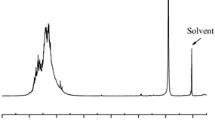Abstract
Polyurethane networks from soybean oil have a number of valuable properties, which are determined by their chemical composition and cross-linking density. Changing the molar ratio of reacting groups can vary the latter. In this work we have varied the NCO/OH molar ratio (isocyanate index) from 1.05 to 0.40 in a soy polyol/MDI system, and tested physical and mechanical properties. The degree of swelling in toluene increased from 52–206% by decreasing isocyanate index from 1.05–0.4. The sol fractions and network densities determined from swelling in toluene were compared with ones obtained using the network formation theory based on branching processes. The comparison of experimental sol fractions and network densities with those predicted by theory of network formation suggest that ∼5–10% of bonds are lost in cycles and that high entanglement contributions increase the network densities. Polymers prepared with NCO/OH ratios from 1.05–0.8 were glassy while the others were rubbery, and that was reflected in their properties. Glass transition temperature (DSC) of the networks decreased from 64–7°C, tensile strength from 47–0.3 MPa, and elongation at break increased from 7–232%. The activation energy of the glass transition, determined from dielectric spectra, varied from 222–156 kJ/mol as the molar ratio of NCO to OH groups decreased from 1.05–0.4.
Similar content being viewed by others
REFERENCES
Z. S. Petrovic, A. Guo, and I. Javni (2000) US Patent 6,107,433, Pittsburg State University.
A. Guo, Y. Cho, and Z. S. Petrovic (2000) J. Polymer Sci. Polymer Chem. 38, 3900–3910.
Z. S. Petrovic, A. Guo, and W. Zhang (2000) J. Polymer Sci. Polymer Chem. 38, 4062–4069.
M. Ilavskö (1998) in R. T. F. Stepto (Ed.), Polymer Networks, Principles of Their Formation, Structure and Properties, Blackie Academic and Professional, Chapman and Hall, New York.
M. Ilavskö, K. Bouchal, and K. Dušek (1985) Polymer Bull. 14, 295–300.
M. Ilavskö and K. Dušek (1983) Polymer 24, 981.
K. Dušek (1987) Adv. Polymer Sci. 78, 1–58.
K. Dušek (1984) Macromolecules 17, 716–722.
D. W. V. Krevelen. (1990) Properties of Polymers, Elsevier, Amsterdam.
M. Ilavskö and J. Hrouz (1991) J. Non-Crystalline Solids 131–133, 906–912.
I. Krakovskö, A. Havránek, M. Ilavskö, and K. Dušek (1988) Colloid Polymer Sci. 226 324–332.
Author information
Authors and Affiliations
Corresponding author
Rights and permissions
About this article
Cite this article
Petrović, Z.S., Zhang, W., Zlatanić, A. et al. Effect of OH/NCO Molar Ratio on Properties of Soy-Based Polyurethane Networks. Journal of Polymers and the Environment 10, 5–12 (2002). https://doi.org/10.1023/A:1021009821007
Issue Date:
DOI: https://doi.org/10.1023/A:1021009821007




